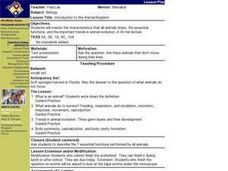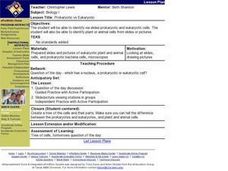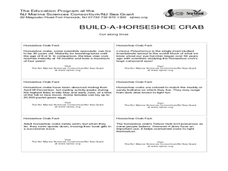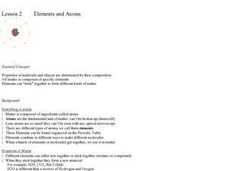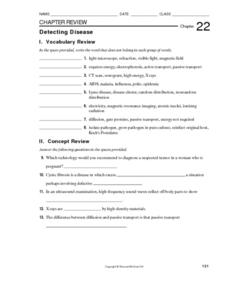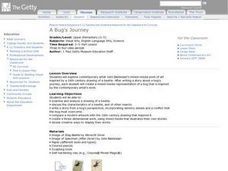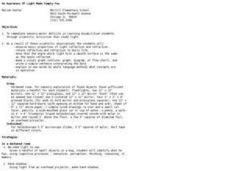Curated OER
Hatching Brine Shrimp
Learners experiment with temperature and salinity to detect favorable environments for hatching brine shrimp eggs. They make some predictions about which environments will yield the most hatched brine shrimp and record the number of...
Curated OER
Tree Friends
Students are introduced to tree structure and use. They identify their special tree using all senses except sight. Students identify six different internal parts within a cross section of tree trunk (bark, phloem, xylem, cambium,...
Curated OER
Introduction to the Animal Kingdom
Learners are asked: Are there animals that don't move during their lives. They are asked what is an animal? Students discuss what animals need to survive. They are taught the trends in animal evolution. Learners discuss the three...
Curated OER
Prokaryotic vs Eukaryotic
Students identify via slides prokaryotic and eukaryotic cells. They identify plant or animal cells from slides or pictures. Students are given the question of the day. They are asked which has a nucleus, a prokaryotic or eukaryotic...
Curated OER
Build-A-Horseshoe Crab
Students discover many facts about horseshoe crabs. Students identify the main body parts of horseshoe crab. They explore the habits of the horseshoe crab and their importances to the ecosystem. Adaptations for younger students are...
Curated OER
Elements And Atoms
Students investigate the concept of elements and atoms. They conduct research using a variety of resources and use the information in order to create a class presentation. The lesson includes specific dialogue and steps for the teacher...
Curated OER
Outbreak!
Students study and research drug-resistant bacteria and the use of antibiotics. Through the use of the internet, and other resources, students gather information and create a board game. They discuss bacteria, antibodies, antibiotics...
Curated OER
Barn Owl Pellet Lab
In this lab worksheet, students dissect a barn owl pellet then identify the different small animals found in the owl pellet. Using class data they calculate percentage present as well as complete 8 post lab questions.
Curated OER
Job Cards
For this job matching worksheet, students match up nine colored cards to nine black and white cards to nine title cards for each profession shown.
Curated OER
What is an animal?
In this animal activity, students determine which characteristic of an animal matches the given statement. Students describe illustrations of animals using the terms radial symmetry, bilateral symmetry, and no symmetry.
Curated OER
The History of Life
In this origin of life instructional activity, students will review the different theories on how life originated on the Earth including the experiments conducted by Louis Pastuer, Francesco Redi, and Miller and Urey. Students will...
Curated OER
Light and Vision
In this light and vision activity, high schoolers will review the characteristics of light including how the eyes use light to see. This activity has 9 fill in the blank, 8 true or false, 9 multiple choice, and 1 short answer question.
Curated OER
Detecting Disease
In this detecting disease worksheet, students will review the different tools scientists use to identify diseases including the steps of Koch's postulates. This worksheet has 14 fill in the blank and 4 short answer questions.
Curated OER
Reproduction
For this reproduction worksheet, students review the processes involved with sexual reproduction in animals and pollination in plants. This worksheet has 6 fill in the blank, 5 true or false, and 9 short answer questions.
Curated OER
The Respiratory System
In this respiratory system worksheet, students review how the air passageways and lungs transport oxygen through the respiratory system. Students also review the mechanics of breathing. This worksheet has 6 multiple choice and 6 true or...
Curated OER
The History of Life
In this history of life worksheet, students complete a crossword puzzle by figuring out the vocabulary words associated with the 11 clues given. Then students review how paleontologists use fossils to learn more about past living things...
Curated OER
Gas Works
In this natural gas history worksheet students respond to 8 short answer questions based on the article about gases around us and their use in world history.
Curated OER
School-Home Links: Spelling Longer Words
For this longer word worksheet, students review the chunking sound method for spelling longer words. Students then study a list of longer words and select four of them to write on the provided lines. Students also write a short sentence...
Curated OER
Voice
In these writing style worksheets, students practice developing their writer's voice. Students complete three activities that help them with their writing voice.
Curated OER
Nouns
In this nouns instructional activity, learners learn what a noun is and pick the correct noun to complete a sentence. There are five sentences to finish.
Curated OER
To Have Or Not To Have Oxygen (Part I - Fermentation)
Students explore the fermentation process. In this biology lesson plan, students describe the process of glycolysis and infer the reactants and products of fermentation.
Curated OER
Soil Examination
Learners examine soil. In this science lesson plan, students recognize different populations in a soil sample, demonstrate and observe water and wind erosion, and construct a levee flood control technique.
Curated OER
A Bug's Journey
Students examine the artwork of John Baldessari that was inspired by a 16th century drawing of a beetle. They analyze a drawing of a beetle, discuss the insect's characteristics, and write a story from the perspective of a bug. Also,...
Curated OER
An Awareness of Light Made Simply Fun
Learners with sensory perception issues discover the properties of light through a series of excellent hands on activities. They look at beams of lights in a darkened room; use a kaleidoscope and optical illusions as they experience the...
Other popular searches
- Parts of a Microscope
- Compound Microscopes
- Label Compound Microscope
- Dissection Microscopes
- Microscope Cheek Cells
- Digital Microscope
- Microscope Lab
- Biology Lab Microscopes
- Scanning Electron Microscopes
- Cheek Cells and Microscopes
- Lesson Plan on Microscopes
- Lenses and Microscopes


